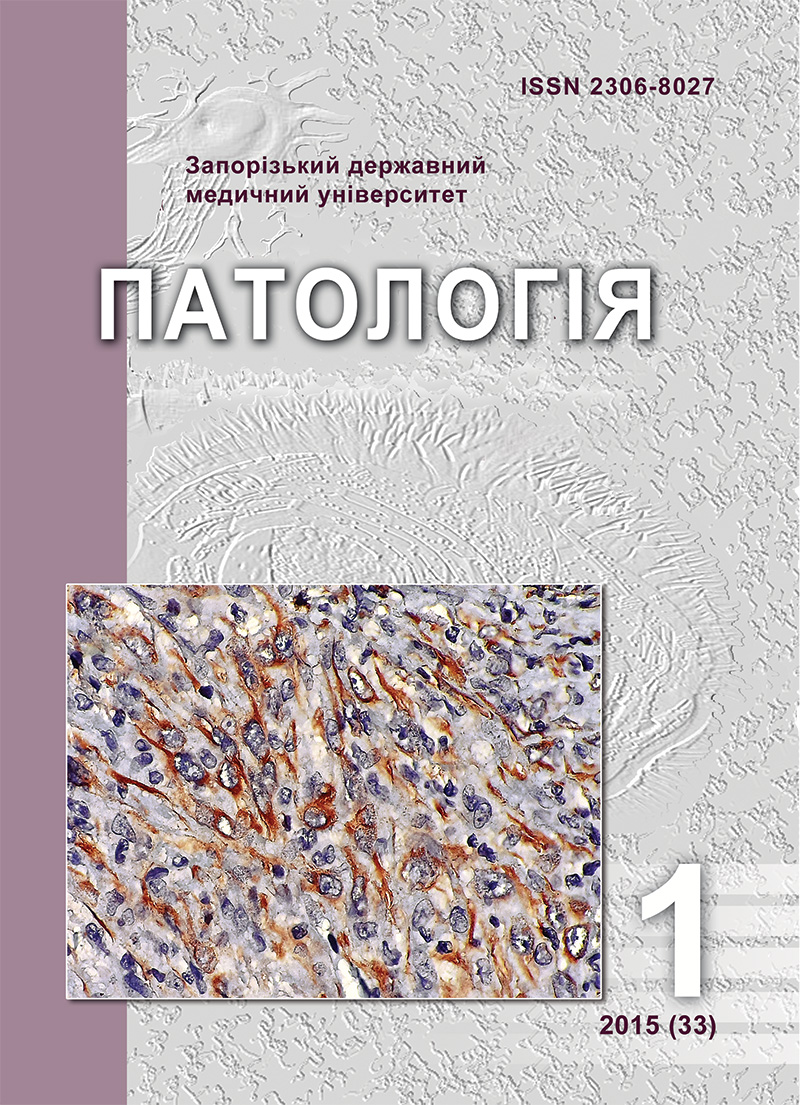Features of reparative regeneration of the liver tissue in rats during experimental tetrachloromethanic and alcoholic hepatitis
DOI:
https://doi.org/10.14739/2310-1237.2015.1.42934Keywords:
Chronic Hepatitis, Liver Cirrhosis, Rats, Carbon Tetrachloride Poisoning, EthanolAbstract
Chronic hepatitises are common pathology of the liver, which often end with the formation of cirrhosis (LC).
Aim. The features of reparative regeneration of liver tissue, as well as pathomorphosis of chronic toxic hepatitis of different etiology, namely tetrachloromethanic (CTH) and alcoholic (CAH), were studied in the experiment in immature rats.
Methods and results. The results of flow cytometric and morphological studies have shown that in rats with CTH significant impairment of lymph flow develops in the form of edema in liver tissue; the number of functioning lymphatic vessels with the presence of lymphangiectasias increases that can significantly influence the processes of fibrogenesis. In rats with CAH fatty liver combined with hydropic one is observed. It was established that a characteristic feature of hepatocytes population of immature rats in CTH is increase of nuclear DNA ploidy>8c, reducing of the percentage of nuclei in the range G0G1 with increasing percentage of cell nuclei in the S-phase, nuclear DNA fragmentation and proliferation index. In CAH, unlike CTH, there was a decrease of synthetic processes in the nuclei of hepatocytes, and polyploidy of nuclear DNA was not observed.
Conclusion. This demonstrates the antiproliferative effect of ethanol.
References
Gavrilyuk, O. M. (2014). Osoblyvosti duktuliarnoi reaktsii pry alkoholnomu, nealkoholnomu steatohepatyti ta virusnomu hepatyti C za rezultatamy imunohistokhimichnoho doslidzhennia [Ductular reaction in alcoholic steatohepatitis, nonalcoholic steatohepatitis and hepatitis C virus infections (immunohistochemical study)]. Patolohiia, 1, 41–44. [in Ukrainian].
Bashkirova, Yu. V., Tarabukina, S. M., Mutaikhan, G., Kolpakova, T. A., Kolpakov, M. A. (2007). Eksperimentalnyie i klinicheskie aspekty primeneniya enterosorbtsii pri khronicheskom toksicheskom gepatite [Experimental and clinical aspects of enterosorbtion in chronic toxic hepatitis]. Sibirskij medicinskij zhurnal, 2, 72–76. [in Russian].
Issa, R., Zhou, X., Trim, N., Millward-Sadler, H., Krane, S., Benyon, C., & Iredale, J. (2003). Mutation in collagen-1 that confers resistance to the action of collagenase results in failure of recovery from CCl4-induced liver fibrosis, persistence of activated hepatic stellate cells, and diminished hepatocyte regeneration. FASEB J., 17, 47-49.
Bielenichev, I. F., Sokolyk, A. P., & Abramov, A. V. (2011). Farmakologichna modulyatsiya signalingu apoptozu neyroniv SA1-zoni gipokampa schuriv z khronichnoyu alkogolnoyu intoksikatsieyu [Pharmacological modulation of neuronal apoptosis syhnalinhu CA1 hippocampal zone rats with chronic alcohol intoxication]. Pharmacology and drug toxicology, 6, 15–21. [in Ukrainian].
Rykalo, N. A., Neshoda, І. І., Rautskis, V. A. (2009). Ukraine Patent 43 704, IPC G09B 23/00. A method of modeling chronic toxic hepatitis and liver cirrhosis in rats immature; owner Vinnitsa National Medical University named after NI Pirogov. - № u200903490; Bull., 16. [in Ukrainian].
Rykalo, N. A. (2011). Patohenez khronichnykh virusnykh hepatytiv V i S u ditei: vikovi osoblyvosti, patohenetychna terapiia (eksperymentalno-klinichne doslidzhennia) (Avtoref. dis… dokt. med. nauk) [Pathogenesis of chronic viral hepatitis B and C in children: age, pathogenetic therapy (experimental and clinical research) Dr. med. sci. diss.] Ternopil, 36. [in Ukrainian].
Kovalyev, G. A., & Petrenko, A. Yu. (2004). E`ksperimental'naya model' alkogol'nogo porazheniya pecheni u samok krys [Еxperimental model of alcoholic liver diseas in female rats]. Visnyk Kharkivskoho natsionalnoho universytetu, 617, 15–18. [in Ukrainian].
Mushkambarov, N. N. & Kuznetsov, S. L. (2007). Molekulyarnaya biologiya : uchebnoe posobie dlya studentov med. vuzov [Molecular biology: a manual for students medical schools]. Moscow: MIA. [in Russian].
Baidyuk, E. V., Shiryaeva, A. P., Bezborodkina, N. N., & Sakuta, G. A. (2009). Sravnitel'nyj analiz morfofunkcional'nykh pokazatelej kul'tury gepatocitov, vydelennykh iz normal'noj i patologicheski izmenennoj pecheni krys [Analysis of functioning and morphology hepatocytes of rats with experimental toxic hepatitis]. Cirologiya, 51(10), 797–805.
Gorla, G. R., Malhi, H. & Gupta, S. (2001). Polyploidy associated with oxidative injury attenuates proliferative potential of cells. J. Cell Sci, 114, 2943–2951.
Santiago, T., Diaz, B. P., Cabrera, J. J., Díaz-Chico, J. C., Díaz-Chico, B. N. & López-Guerra A. (1999). Thyroid hormone regulation of rat hepatocytes proliferation and polyploidization. American Journal of Physiology, (276). 155–163.
Fogt, F. & Nanji, A. A. (1996). Alterations in nuclear ploidy and cell phase distribution of rat liver cells in experimental alcoholic liver disease : relationship to antioxidant enzyme gene expression. Toxicology and applied pharmacology, 136, 87–93.
Downloads
How to Cite
Issue
Section
License
Authors retain copyright and grant the journal right of first publication with the work simultaneously licensed under a Creative Commons Attribution License that allows others to share the work with an acknowledgement of the work's authorship and initial publication in this journal.



